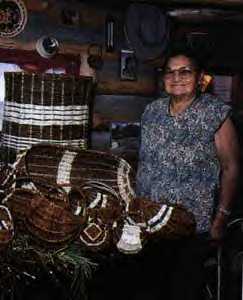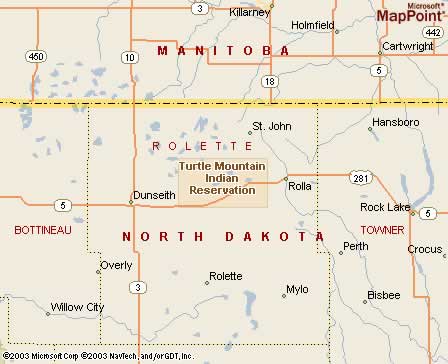|
|
Canku Ota |
|
|
(Many Paths) |
||
|
An Online Newsletter Celebrating Native America |
||
|
January 24, 2004 - Issue 105 |
||
|
|
||
|
REMEMBERING A
LIFE: |
||
|
by Dorreen Yellow Bird - Grand
Forks (ND) Herald Staff Writer
|
||
|
Photo Rose Cree with her red
willow baskets
|
|
The art world will remember Cree as one of the most skilled and talented red willow basket weavers in modern times. Cree passed away Tuesday, surrounded by her children and grandchildren in her home in Dunseith, N.D. She was 82. Cree and her husband Francis began weaving baskets back in 1965. "See, this culture almost died out," she told the Herald in 1989. "I learned from my mother in 1936. We started picking it up again so it wouldn't be lost." Francis Cree would cut willow branches and shape them to make frames. Rose Cree did the actual weaving using willow soaked in water. Fifteen years ago, they sold the baskets for $12 to $125. Today they're worth much more. Some of her red willow baskets are displayed in the Smithsonian in New York City. Other willow baskets can be found in museums across the United States, Canada and other countries. The couple were honored with a Governor's Award for the Arts in 1985. In 2002, they were awarded the National Heritage Fellowship, the country's highest honor in the folk and traditional arts. The award included $10,000 for each artist. U.S. Sens. Byron Dorgan and Kent Conrad presented them an award for lifetime achievement in 2003 from the National Endowment of the Arts. Nearly
blind DeLong-Monette said Cree was her mentor and spiritual guide. Francis is a spiritual leader for the tribe. Cree went with her husband when he traveled, tending to the spiritual needs of the people. Though she couldn't see, she helped him by remembering names and information. He didn't need to write anything down. She remembered for him, DeLong-Monette said. "She couldn't see me, but she knew me by my voice and the fragrance of my perfume," DeLong-Monette said. "I remember when her son was having problems making a pair of moccasins. Cree took the moccasins and with her fingers helped him through the problem. She was like that." ? Spiritual
guidance She was plagued with hip problems that made walking difficult, but, in spite of her health problems, she would crawl on her hands and knees into the sweat lodges for ceremonies -- sometimes when it was 20 or 30 below outside, DeLong-Monette said. Cree would go into the sweat lodges day after day if someone needed her spiritual guidance. She also provided guidance and mentoring for women who wanted to fast. One of her greatest loves was traditional dancing. She danced in August at the "Thirty Dance" (Sundancing). She attended powwows and ceremonies and danced when she could. She lived a traditional life, raising her 14 children to understand the traditions of the Turtle Mountain Band of Chippewa. She left a legacy of culture, history and language for her children and the people at Turtle Mountain. Cree was born July 21, 1921, to Thomas Machipiness and Pearl Little Boy. She attended boarding school in Fort Totten, N.D. At 18, she returned home to the Turtle Mountains. She and her husband were married for 64 years. She had more than 130 grandchildren and great-grandchildren and five great-great-grandchildren. She had many adopted children. "I can't think of her without smiling," DeLong-Monette said. |
|
|
www.expedia.com |
|
|
||
|
|
||
| Canku Ota is a free Newsletter celebrating Native America, its traditions and accomplishments . We do not provide subscriber or visitor names to anyone. Some articles presented in Canku Ota may contain copyright material. We have received appropriate permissions for republishing any articles. Material appearing here is distributed without profit or monetary gain to those who have expressed an interest. This is in accordance with Title 17 U.S.C. Section 107. | ||
|
Canku Ota is a copyright © 2000, 2001, 2002, 2003, 2004 of Vicki Lockard and Paul Barry. |
||
 |
 |
|
|
The "Canku Ota - A Newsletter Celebrating Native America" web site and its design is the |
||
|
Copyright © 1999, 2000, 2001, 2002, 2003, 2004 of Paul C. Barry. |
||
|
All Rights Reserved. |
||
 Native
American people, particularly those of the Turtle Mountain Band
of Chippewa, will remember Rose Machipiness Old Eagle Woman Cree
-- Mindimooye Ginew Ikwe -- as a teacher, spiritual guide and a
woman who always did for others.
Native
American people, particularly those of the Turtle Mountain Band
of Chippewa, will remember Rose Machipiness Old Eagle Woman Cree
-- Mindimooye Ginew Ikwe -- as a teacher, spiritual guide and a
woman who always did for others. 